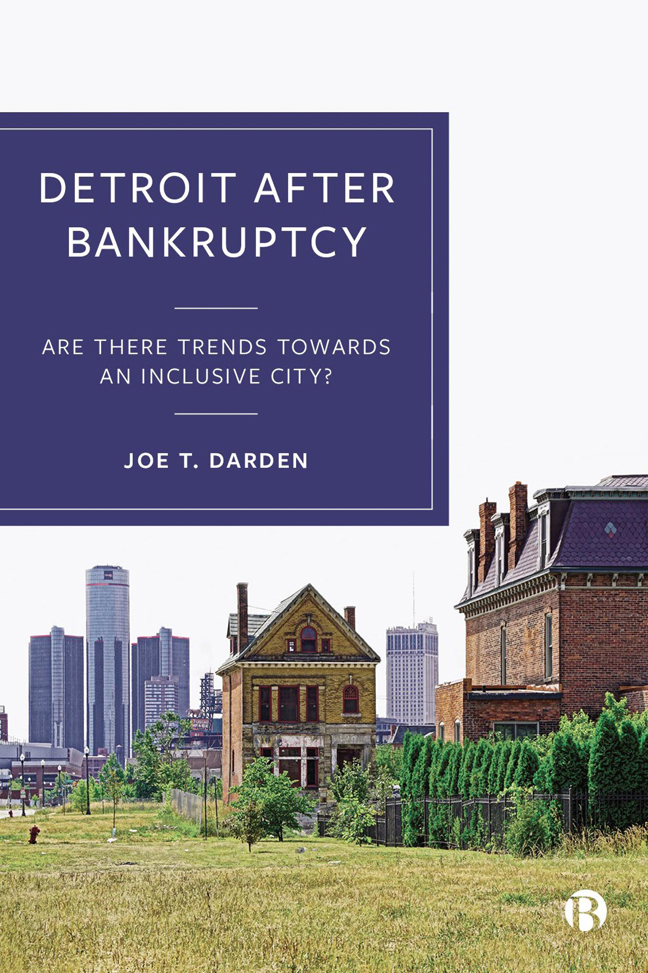Book contents
- Frontmatter
- Dedication
- Contents
- List of Figures and Tables
- Acknowledgments
- Preface
- 1 Antecedents to Bankruptcy
- 2 Detroit Bankruptcy: The Characteristics of the Decision Makers and the Differential Benefits Afterwards
- 3 The Postbankruptcy Social and Spatial Structure of Metropolitan Detroit: Anatomy of Class and Racial Residential Segregation
- 4 Gentrification: A New Method to Measure Where the Process Is Occurring by Neighborhood
- 5 The Uneven Distribution of Economic Redevelopment: Which Neighborhoods Are Excluded?
- 6 Black and Hispanic Underrepresentation in Business Ownership in a Majority-Black City
- 7 Racial Inequality in Student Academic Achievement Levels: A Neighborhood Solution to the Problem
- 8 Unequal Exposure to Crime in the City of Detroit: A New Method to Measure Exposure by the Characteristics of Neighborhoods
- 9 Solving the Problem of Extreme Race and Class Inequality: Implementing the Spatial Mobility Alternative
- 10 Conclusions: The Status of the Residents of Detroit after Bankruptcy
- References
- Index
9 - Solving the Problem of Extreme Race and Class Inequality: Implementing the Spatial Mobility Alternative
Published online by Cambridge University Press: 25 January 2024
- Frontmatter
- Dedication
- Contents
- List of Figures and Tables
- Acknowledgments
- Preface
- 1 Antecedents to Bankruptcy
- 2 Detroit Bankruptcy: The Characteristics of the Decision Makers and the Differential Benefits Afterwards
- 3 The Postbankruptcy Social and Spatial Structure of Metropolitan Detroit: Anatomy of Class and Racial Residential Segregation
- 4 Gentrification: A New Method to Measure Where the Process Is Occurring by Neighborhood
- 5 The Uneven Distribution of Economic Redevelopment: Which Neighborhoods Are Excluded?
- 6 Black and Hispanic Underrepresentation in Business Ownership in a Majority-Black City
- 7 Racial Inequality in Student Academic Achievement Levels: A Neighborhood Solution to the Problem
- 8 Unequal Exposure to Crime in the City of Detroit: A New Method to Measure Exposure by the Characteristics of Neighborhoods
- 9 Solving the Problem of Extreme Race and Class Inequality: Implementing the Spatial Mobility Alternative
- 10 Conclusions: The Status of the Residents of Detroit after Bankruptcy
- References
- Index
Summary
Introduction
The social and economic characteristics of neighborhoods in Detroit were influenced tremendously by the city's bankruptcy, which made conditions for a large segment of the Detroit population much more difficult. Many residents of Black and Hispanic neighborhoods were exposed to more poverty and higher rates of unemployment. Some residents had more difficulty finding jobs in higher occupations at the management and professional levels (Ihlanfeldt and Sjoquist, 1991). Other residents were not residing in the same neighborhoods as highly educated residents and they experienced wage inequality. Some residents had difficulty becoming homeowners, and those who did own their home often had a lower home value.
When such conditions exist, it is quite common for residents to search for neighborhoods and places that will improve their quality of life, even if this means moving away from the city and the neighborhood where they have lived most of their lives. Urban geographers call this search by residents the geography of opportunity (Rosenbaum, 1995; Rosenbaum, Reynolds, and De Luca, 2002; Goering and Feins, 2003; Galster, 2017). The movement away from the city has also been called the spatial mobility alternative (Darden and Thomas, 2013: 298–317). In Darden and Thomas’ Detroit: Race Riots, Racial Conflicts, and Efforts to Bridge the Racial Divide (2013), the argument was made, citing migration theory, that residents often move due to two major factors: (1) push, and (2) pull (Greenwood, 1985; Darden and Thomas, 2013). The push factors impacting residents in Detroit include the already-mentioned factors, plus the low quality of education provided by the Detroit public schools and the lack of affordable quality housing in most neighborhoods. The research questions that this chapter aims to answer are whether the quality of life changed for residents of Detroit after bankruptcy, and what were the social and economic characteristics of municipalities in the suburbs compared to social and economic characteristics of the neighborhoods in Detroit.
- Type
- Chapter
- Information
- Detroit after BankruptcyAre There Trends towards an Inclusive City?, pp. 162 - 188Publisher: Bristol University PressPrint publication year: 2023



